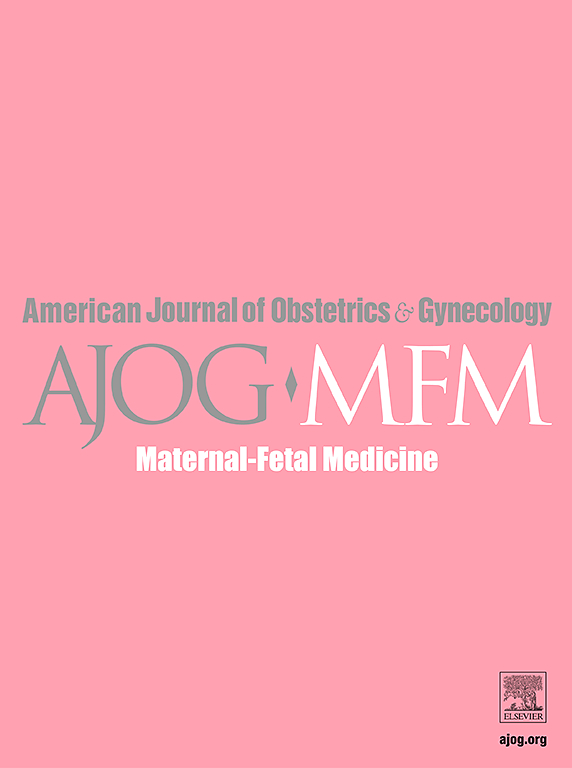Pregnancy Characteristics and Outcomes in Monochorionic Diamniotic Twin Pregnancies Complicated by Proximal Placental Cord Insertions From a Single Center
IF 3.1
2区 医学
Q1 OBSTETRICS & GYNECOLOGY
American Journal of Obstetrics & Gynecology Mfm
Pub Date : 2025-08-18
DOI:10.1016/j.ajogmf.2025.101761
引用次数: 0
Abstract
Background
Proximal placental cord insertion (pPCI), defined as a ≤4 cm distance between umbilical cord insertions, is a distinct anomaly observed in monochorionic diamniotic (MCDA) twin pregnancies, characterized by the umbilical cords of both fetuses inserting in close proximity within the placental tissue. There is limited available data on the pregnancy characteristics and outcomes in monochorionic diamniotic twins with proximal placental cord insertions (pPCI).
Objectives
To investigate pregnancy characteristics in monochorionic diamniotic (MCDA) twins complicated by pPCI and compare outcomes with nonproximal PCI (nPCI) cases.
Methods
Single center retrospective cohort study of MCDA pregnancies evaluated from 2010 to 2023. pPCI was defined as a ≤4 cm distance between cord insertions on standardized prenatal ultrasound. Maternal characteristics, prenatal diagnoses, interventions, and perinatal outcomes were compared between pPCI and nPCI groups. The primary outcome was perinatal loss, defined as no live births or survival of only 1 fetus to hospital discharge. Multivariable logistic regression was performed to identify predictors of adverse outcomes.
Results
A total of 59 pregnancies with pPCI and 1319 pregnancies with nPCI were identified. The pPCI group had higher rates of selective fetal growth restriction (sFGR; 42.4% vs 26.3%, p=0.), type III sFGR (20.3% vs 8.8%, p=.009), and abnormal umbilical artery (UA) Dopplers without definitive diagnosis (11.9% vs 0.2%, p<.0001). Twin to twin transfusion syndrome (TTTS) was less common in the pPCI group (23.7% vs 48.2%, p=.0003). Intervention was performed less frequently in pPCI (45.8% vs 58.5%, p=.05), with higher use of radiofrequency ablation (RFA) (37.3% vs 17.1%, p=.0004) and lower use of laser photocoagulation (3.4% vs 38.3%, p<.0001). Overall perinatal loss did not differ significantly (25.9% vs 21.2%, p=.25), but in the intervention subgroup, the pPCI group had significantly higher rates of “no survivors to hospital discharge” (25.9% vs 11.8%, p=.04). pPCI, sFGR, and gestational age at delivery were independently associated with no survivors to hospital discharge.
Conclusion
Proximal cord insertion is an uncommon but clinically relevant finding in MCDA twin pregnancies, associated with a distinct prenatal phenotype. While overall perinatal loss was similar, pPCI was independently associated with adverse outcomes following intervention. Early recognition of pPCI may inform risk stratification, surveillance, and counseling in monochorionic pregnancies. Abnormal UA Dopplers in the absence of other monochorionic pathology should prompt consideration of pPCI.
单绒毛膜双羊膜双胎妊娠合并近端胎盘脐带插入的妊娠特点和结局。
背景:近端胎盘脐带插入(pPCI),定义为脐带插入之间的距离≤4cm,是单绒毛膜双胎(MCDA)双胎妊娠中观察到的明显异常,其特征是两个胎儿的脐带靠近胎盘组织插入。关于单绒毛膜双羊膜双胞胎胎盘近端脐带插入(pPCI)的妊娠特征和结局的可用数据有限。目的:探讨单绒毛膜双羊膜(MCDA)双胞胎合并近端胎盘脐带插入(pPCI)的妊娠特点,并与非近端PCI (nPCI)病例的结局进行比较。方法:2010 ~ 2023年MCDA妊娠的单中心回顾性队列研究。pPCI定义为标准化产前超声检查脐带插入距离≤4cm。比较pPCI组和nPCI组的产妇特征、产前诊断、干预措施和围产期结局。主要结局是围产期损失,定义为没有活产或只有一个胎儿存活至出院。采用多变量逻辑回归来确定不良结果的预测因素。结果:共发现59例pPCI妊娠和1319例nPCI妊娠。pPCI组有较高的选择性胎儿生长受限(sFGR, 42.4%比26.3%,p=0.01)、III型sFGR(20.3%比8.8%,p=0.009)和未明确诊断的脐动脉(UA)多普里异常(11.9%比0.2%,p)的发生率。结论:近端脐带插入在MCDA双胎妊娠中不常见,但与临床相关,与独特的产前表型相关。虽然总体围产儿损失相似,但pPCI与干预后的不良结局独立相关。早期识别pPCI可以为单绒毛膜妊娠的风险分层、监测和咨询提供信息。在没有其他单绒毛膜病理的情况下,异常UA多普勒应提示考虑pPCI。
本文章由计算机程序翻译,如有差异,请以英文原文为准。
求助全文
约1分钟内获得全文
求助全文
来源期刊

American Journal of Obstetrics & Gynecology Mfm
Medicine-Medicine (all)
CiteScore
7.40
自引率
3.20%
发文量
254
审稿时长
40 days
期刊介绍:
The American Journal of Obstetrics and Gynecology (AJOG) is a highly esteemed publication with two companion titles. One of these is the American Journal of Obstetrics and Gynecology Maternal-Fetal Medicine (AJOG MFM), which is dedicated to the latest research in the field of maternal-fetal medicine, specifically concerning high-risk pregnancies. The journal encompasses a wide range of topics, including:
Maternal Complications: It addresses significant studies that have the potential to change clinical practice regarding complications faced by pregnant women.
Fetal Complications: The journal covers prenatal diagnosis, ultrasound, and genetic issues related to the fetus, providing insights into the management and care of fetal health.
Prenatal Care: It discusses the best practices in prenatal care to ensure the health and well-being of both the mother and the unborn child.
Intrapartum Care: It provides guidance on the care provided during the childbirth process, which is critical for the safety of both mother and baby.
Postpartum Issues: The journal also tackles issues that arise after childbirth, focusing on the postpartum period and its implications for maternal health. AJOG MFM serves as a reliable forum for peer-reviewed research, with a preference for randomized trials and meta-analyses. The goal is to equip researchers and clinicians with the most current information and evidence-based strategies to effectively manage high-risk pregnancies and to provide the best possible care for mothers and their unborn children.
 求助内容:
求助内容: 应助结果提醒方式:
应助结果提醒方式:


